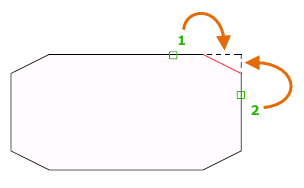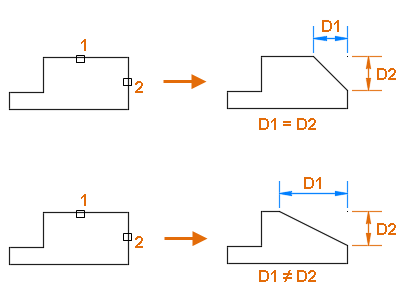CHAMFER (Command)
Bevels or chamfers the edges of two 2D objects or the adjacent faces of a 3D solid. A bevel or chamfer is an angled line that meets the endpoints of two straight 2D objects.
The distances and angles that you specify are applied in the order that you select the objects.

Create 2D Chamfers
A bevel or chamfer can be defined by selecting two objects of the same or different object types: lines, polylines, rays, and xlines.
If the two selected objects are on the same layer, the line defined is created on that layer. Otherwise, the line is created on the current layer. The layer affects object properties including color and linetype.
The following prompts are displayed when creating a 2D chamfer.
First Line
Select the first of two objects or the first line segment of a 2D polyline to define the chamfer.

Second line or shift-select to apply corner
Select the second object or line segment of a 2D polyline to define the chamfer.
You can also hold down the Shift key before selecting the second object or line segment of a 2D polyline to extend or trim the selected objects to form a sharp corner. While Shift is held down, a temporary value of zero is assigned to the current chamfer distance and angle values.
If the selected objects are straight line segments of a 2D polyline, the line segments can be adjacent to each other or separated by one other segment. When the selected segments are separated by a segment, the segment that separates them is removed and replaced with the chamfer.
Undo
Reverses the previous action in the command.
Polyline
Inserts a chamfer line at each vertex of a 2D polyline where two straight line segments meet. The chamfer lines become new segments of the polyline, unless the Trim option is set to No Trim.

Distance
Sets the chamfer distances from the intersecting points of the first and second objects.
If both distances are set to zero, the selected objects or line segments are extended or trimmed so they intersect.

Angle
Sets the chamfer distance from the intersecting point of the selected objects and the XY angle from the first object or line segment.
If both values are set to zero, the selected objects or line segments are extended or trimmed so they intersect.

Trim
Controls whether the selected objects are trimmed to meet the endpoints of the chamfer line.
- Trim. Selected objects or line segments are trimmed to meet the endpoints of the chamfer line. If the selected objects or line segments do not intersect with the chamfer line, they are extended or trimmed before the chamfer line is added.
- No Trim. Selected objects or line segments are not trimmed before the chamfer line is added.
Method
Controls how the chamfer line is calculated from the intersecting point of the selected objects or line segments.
- Distance. Chamfer line is defined by two distances.
- Angle. Chamfer line is defined by a distance and an angle.
Multiple
Allows for the beveling of more than one set of objects.